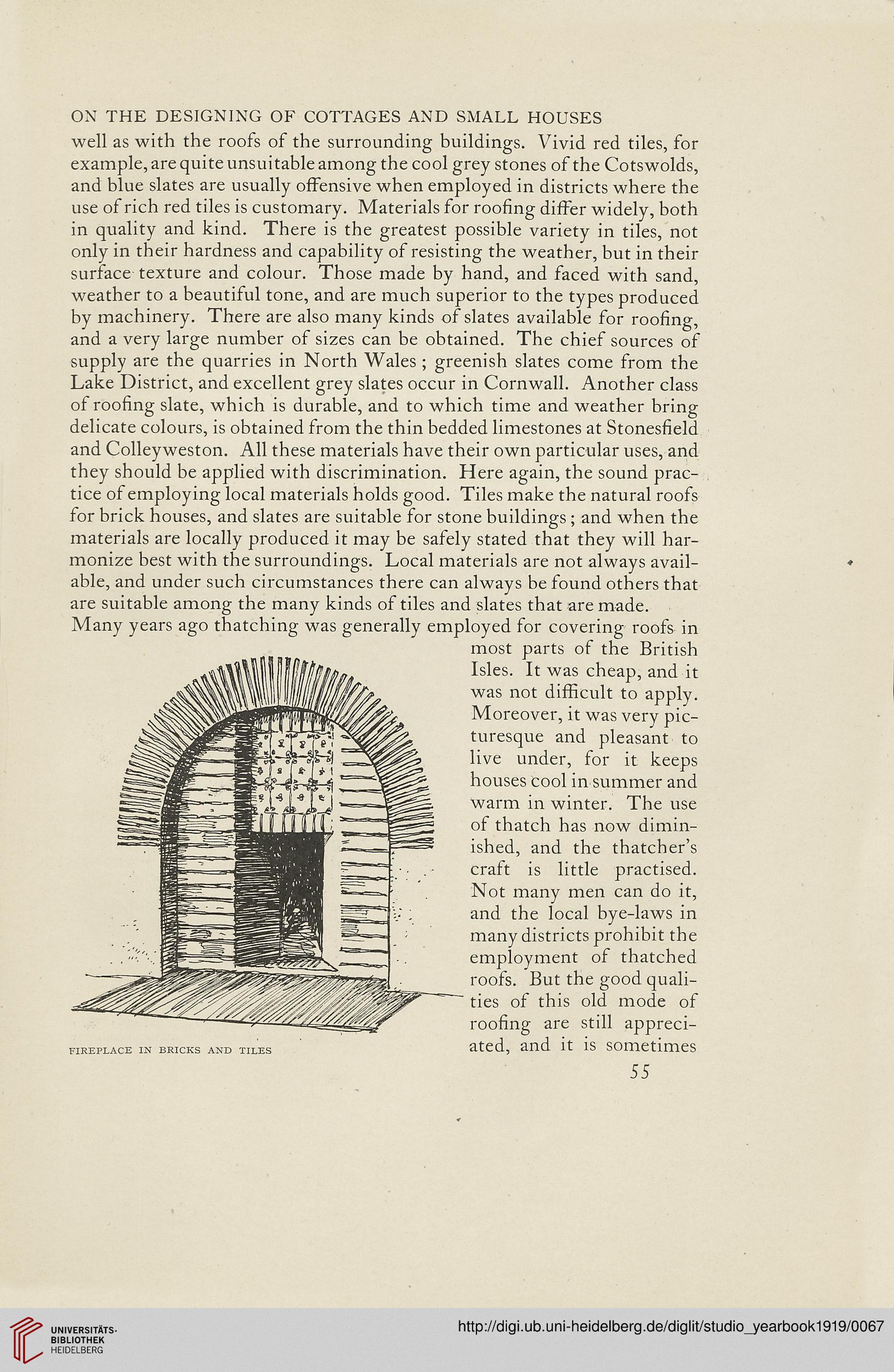ON THE DESIGNING OF COTTAGES AND SMALL HOUSES
well as with the roofs of the surrounding buildings. Vivid red tiles, for
example, are quite unsuitable among the cool grey stones of the Cotswolds,
and blue slates are usually offensive when employed in districts where the
use of rich red tiles is customary. Materials for roofing differ widely, both
in quality and kind. There is the greatest possible variety in tiles, not
only in their hardness and capability of resisting the weather, but in their
surface texture and colour. Those made by hand, and faced with sand,
weather to a beautiful tone, and are much superior to the types produced
by machinery. There are also many kinds of slates available for roofing,
and a very large number of sizes can be obtained. The chief sources of
supply are the quarries in North Wales ; greenish slates come from the
Lake District, and excellent grey slates occur in Cornwall. Another class
of roofing slate, which is durable, and to which time and weather bring
delicate colours, is obtained from the thin bedded limestones at Stonesfield
and Colleyweston. All these materials have their own particular uses, and
they should be applied with discrimination. Here again, the sound prac-
tice of employing local materials holds good. Tiles make the natural roofs
for brick houses, and slates are suitable for stone buildings; and when the
materials are locally produced it may be safely stated that they will har-
monize best with the surroundings. Local materials are not always avail-
able, and under such circumstances there can always be found others that
are suitable among the many kinds of tiles and slates that are made.
Many years ago thatching was generally employed for covering roofs in
most parts of the British
Isles. It was cheap, and it
was not difficult to apply.
Moreover, it was very pic-
turesque and pleasant to
live under, for it keeps
houses Cool in summer and
warm in winter. The use
of thatch has now dimin-
ished, and the thatcher’s
craft is little practised.
Not many men can do it,
and the local bye-laws in
many districts prohibit the
employment of thatched
roofs. But the good quali-
ties of this old mode of
roofing are still appreci-
ated, and it is sometimes
55
FIREPLACE IN BRICKS AND TILES
well as with the roofs of the surrounding buildings. Vivid red tiles, for
example, are quite unsuitable among the cool grey stones of the Cotswolds,
and blue slates are usually offensive when employed in districts where the
use of rich red tiles is customary. Materials for roofing differ widely, both
in quality and kind. There is the greatest possible variety in tiles, not
only in their hardness and capability of resisting the weather, but in their
surface texture and colour. Those made by hand, and faced with sand,
weather to a beautiful tone, and are much superior to the types produced
by machinery. There are also many kinds of slates available for roofing,
and a very large number of sizes can be obtained. The chief sources of
supply are the quarries in North Wales ; greenish slates come from the
Lake District, and excellent grey slates occur in Cornwall. Another class
of roofing slate, which is durable, and to which time and weather bring
delicate colours, is obtained from the thin bedded limestones at Stonesfield
and Colleyweston. All these materials have their own particular uses, and
they should be applied with discrimination. Here again, the sound prac-
tice of employing local materials holds good. Tiles make the natural roofs
for brick houses, and slates are suitable for stone buildings; and when the
materials are locally produced it may be safely stated that they will har-
monize best with the surroundings. Local materials are not always avail-
able, and under such circumstances there can always be found others that
are suitable among the many kinds of tiles and slates that are made.
Many years ago thatching was generally employed for covering roofs in
most parts of the British
Isles. It was cheap, and it
was not difficult to apply.
Moreover, it was very pic-
turesque and pleasant to
live under, for it keeps
houses Cool in summer and
warm in winter. The use
of thatch has now dimin-
ished, and the thatcher’s
craft is little practised.
Not many men can do it,
and the local bye-laws in
many districts prohibit the
employment of thatched
roofs. But the good quali-
ties of this old mode of
roofing are still appreci-
ated, and it is sometimes
55
FIREPLACE IN BRICKS AND TILES




